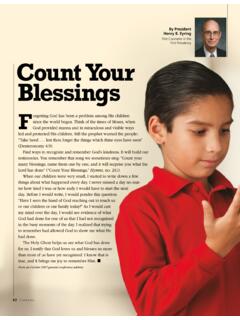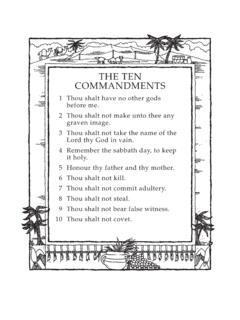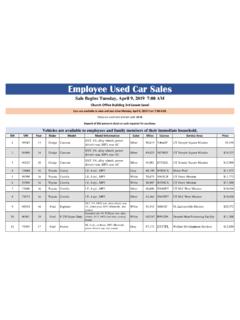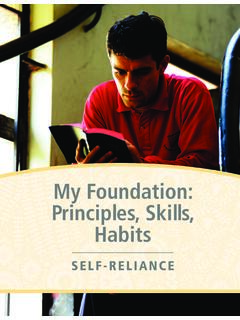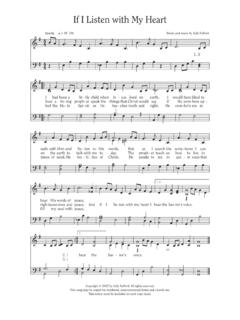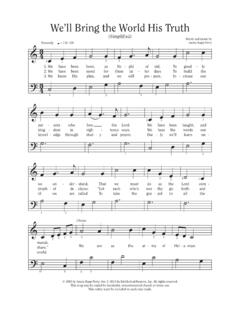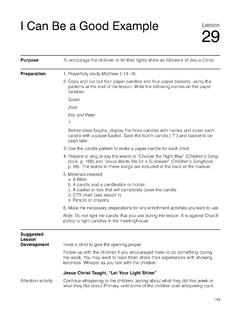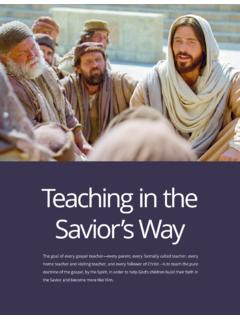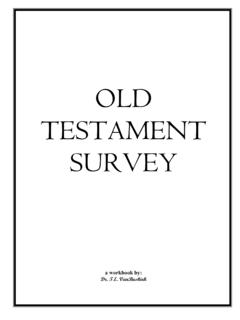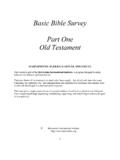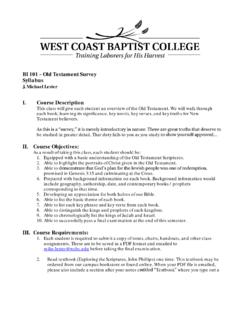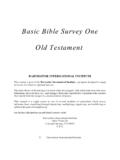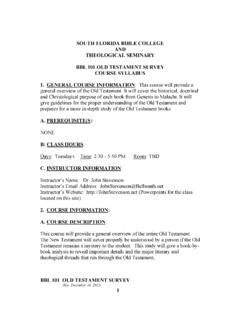Transcription of Old Testament
1 IGenesis Ruth Learning Assessment Form A Old Testament Old Testament Seminary Teacher Manual Published by The Church of Jesus Christ of Latter-day Saints Salt Lake City, Utah 2015 by Intellectual Reserve, Inc. All rights reserved. English approval: 1/15 PD10052273iiCONTENTST eacher PacketIntroduction 1 Administering the Learning Assessment 1 Reviewing the Learning Assessment 1 Making Accommodations for students with Disabilities 2 Sending Answer Sheets and Feedback to the Seminaries and Institutes Office of Research 3 Study Guide 4 Correct-Response Guide for Section 1: Multiple Choice 5 Correct-Response Guide for Section 2: Explain Doctrine 12 Student Learning-Assessment PacketAnswer Sheet for Genesis Ruth Learning Assessment, Form A 15 Section 1: Multiple Choice 16 Section 2: Explain Doctrine 20 Section 3: Belief and Apply Surveys 211 IntroductionThis learning assessment is for seminary students . Teachers should administer the assessment after they have taught the corresponding seminary curriculum learning assessment is a 60-minute learning experience.
2 In a daily class, administering the assessment will take one class period, or 40 minutes. Reviewing the assessment with your class will be done the following class period. Classes that meet longer than 60 minutes should take only one class period to administer and review the the Learning Assessment (AVERAGE TIME: 40 MINUTES)1. Before the day that students take the assessment, identify students who may need accommodations because of specific needs, disabilities, or health-related conditions. Share the following statement with your class two or three days before giving the assessment:Testing accommodations can be made for students with specific needs, disabilities, or health-related conditions that prevent them from participating in the assessment on an equal basis with other you have a specific need, disability, or health-related condition that may prevent you from participating in the assessment on an equal basis with your peers, please talk with me to discuss possible testing accommodations that may help appropriate accommodations to meet the specific needs, disabilities, or health-related conditions identified (see the Making Accommodations for students with Disabilities section on page 2).
3 2. Make one copy of the Student Learning-Assessment Packet for each student. Print the packets on white Ensure that each student has a pencil that can create dark circles and an eraser as he or she fills in the answer sheet. Do not use red scripture-marking Pass out the copies of the Student Learning-Assessment Packet to the Instruct students to write their names on their answer Write the program ID number on the board. Have students mark the program ID on their answer Read the following instructions to your class in a professional manner:The purpose of this learning assessment is to see how well you understand what we have studied in this class and to help you continue learning. There are three sections: multiple choice, explain doctrine, and survey . You may not use your scriptures during the give your best efforts on this assessment. You may the Learning Assessment1. Provide one copy of the Correct-Response Guide for Section 2: Explain Doctrine for each student. Instruct the students to self-grade what they wrote in the explain-doctrine section.
4 Some students will finish before others, so ask those who finish early to remain quiet as others finish their Packet22. After all students have finished, review the multiple-choice answers as a class. Ask students to grade their own answers as you read the correct answers aloud. (For example, The answer to number 1 is c, number 2 is a, .. ) Use the correct-response guides in the teacher packet to explain and discuss answers to any of the learning-assessment questions students may not students should keep their Belief and Apply Surveys. Take a few minutes to explain the importance of evaluating how well they are applying gospel principles in their lives. Do not ask students to share their specific responses on the suveys, but have a discussion that helps them see and feel the importance of striving to become better in applying gospel principles in their lives. Encourage them to take a minute to write down what they feel will help deepen their testimony of these doctrines and principles.
5 Ideas may include setting a goal to start doing some of the things or to do them better, to do some things more sincerely, or to share what they know about the gospel with friends or Instruct students to write the number of questions they correctly answered in the top-right corner of their answer sheet and give their answer sheets and explain-doctrine responses to you. students should keep their completed Belief and Apply Enter the student results into the WISE Gradebook. Select Yes for students who answered 75 percent or more of the questions correctly. Select No for students who answered less than 75 percent of the questions correctly. (For this 36-question learning assessment, students should answer 27 or more questions correctly to pass.)6. If any students answered less than 75 percent of the questions correctly, work with them to help them pass the learning assessment. Encourage them to study and take the learning assessment again. Based on the students needs and abilities, you may suggest that they use their scriptures, the teacher, a parent, a Church leader, or a knowledgeable friend to help them find the answers during these additional attempts.
6 The learning assessment can help students learn some of the important doctrines, principles, scripture mastery, content, and context of the course. Make adaptations as necessary to meet the needs and abilities of your Update the results in the WISE Gradebook after a student passes the assessment. Change the results from No to Yes for that Accommodations for students with DisabilitiesThe purpose of assessment accommodations is to enable students with specific needs, disabilities, or health-related conditions to participate in the assessment on an equal basis with other students . Teachers should make appropriate accommodations to meet the specific needs, disabilities, and health-related conditions of their students . The following are guidelines to consider as you make accommodations for your students :1. Identify students who may have specific needs or disabilities. Have a private conversation with each student to identify his or her specific need(s). Listen attentively, and be positive.
7 You may consider having conversations with these students parents or Church leaders to help you better understand their specific need(s).2. Based on your conversations, make a plan that appropriately accommodates the student s specific need(s).3. Implement the accommodations. Individual accommodations should remain confidential. It is impossible to list all of the possible accommodations; however, the following are several examples of possible accommodations:Presentation: Provide the student with an audio version of the assessment, present the instructions and assessment orally, or provide the student with a large-print version of the assessment (see the Learning Assessments website for the currently available formats of the assessment).Setting: Provide the student with preferential seating in the classroom, provide a space with minimal distractions, or administer the assessment in a small-group setting or in another scheduling: Administer the assessment in several sessions or over several days, allow the various parts of the assessment to be taken in a different order, administer the assessment at a specific time of day, or allow extended time to complete the : Allow the student to make verbal responses of his or her answer choices, allow for answers to be dictated to a scribe or recorder, or permit answers to be marked in the assessment booklet rather than on the answer Avoid making accommodations that change or reduce the learning expectations of the Have Christlike love for each student, and follow the promptings of the Spirit as you make accommodations to meet students Go to the following Church website to find more general information on helping individuals with disabilities.
8 Answer Sheets and Feedback to the Seminaries and Institutes Office of Research (OPTIONAL)Sending in your students answer sheets and providing feedback to the Seminaries and Institutes of Religion Office of Research provides valuable information that will be used by Seminaries and Institutes of Religion administrators to improve this assessment and Seminaries and Institutes of Religion curriculum. A reporting system for these assessments is currently being developed. However, until that system is operating, no teacher reports can be returned to teachers. If you wish to send your students results or feedback, do one of the following:1. Mail your answer sheets to:Seminaries and Institutes of Religion Office of Research 50 East North Temple Street Salt Lake City, UT 84150-00092. Scan and email your answer sheets by following these steps:a. Scan the answer sheets at 300 dots per inch (dpi) resolution and save them to a computer. Make sure all pages scan Compile all scans into one PDF file per teacher, not 30 separate PDF files for 30 Email the PDF files to If the file is more than 12 MB, use FileSend at You may also use personal file-sharing services, such as Dropbox or Box, to send your files to Your feedback and suggestions are appreciated.
9 We welcome your comments regarding the assessment, the assessment process, challenges, and successes. survey link: Learning Assessment Feedback Email: Mail comments to the above mastery questions: Understand the doctrines taught in the scripture mastery verses. Moses 1:39 Moses 7:18 Abraham 3:22 23 Genesis 1:26 27 Genesis 2:24 Genesis 39:9 Exodus 19:5 6 Exodus 20:3 17 Joshua 24:15 Context questions: Understand some of the key accounts, individuals, time periods, and symbolism. The most important message of the Old Testament and what most of the symbols, laws, images, prophecies, and events of the Old Testament refer to or represent (see Moses 5:7 8; Mosiah 3:13 15) Symbolism of the blood on the doorposts (see Exodus 12:21 23), the brass serpent (see Numbers 21:8 9; Alma 33:19 22), and Abraham being asked to sacrifice Isaac (see Genesis 22:10 12; John 3:16) What Moses knew that helped him overcome Satan (see Moses 1:4 7, 13) Commandments given to Adam and Eve in the Garden of Eden (see Moses 2:26 30; 3:16 17) Noah and the Flood: how the Flood might be considered a blessing to spirits not yet born and to the wicked living at the time of the Flood (see Moses 8:22 30; 2 Nephi 26:24; Old Testament Study Guide for Home-Study Seminary students [2015], 38) Jacob and Esau: the choices Esau made that showed he despised his birthright (see Genesis 25:29 34; 26:34 35.)
10 Old Testament Study Guide, 65 66) Joseph sold into Egypt: lessons learned about trials (see Genesis 45:7 8; 50:20 21) Moses s calling to deliver Israel: what God told Moses to help him overcome his doubt (see Exodus 3:12, 17) Key lessons learned from Israel in the wilderness: what the Lord gave Israel daily to remember Him (see Exodus 16:4 5), blessings of the tabernacle (see Exodus 25:8, 22; 29:43 46), how sacrifices described in the book of Leviticus pointed Israel to Jesus Christ (see Leviticus 1:3 9; 4:20 31; 16:21 22), and Caleb and Joshua s response to the evil report (see Numbers 14:7 9) Lessons learned from entering the promised land and overtaking Jericho (see Joshua 6) The general timeline of key prophets: Adam, Enoch, Noah, Abraham, and Moses (see Bible Chronology in the Bible appendix; see also ) Major individuals in the first part of the Old Testament : Adam, Eve, Moses, Enoch, Noah, Abraham, Lot, Sarah, Isaac, Rebekah, Jacob, Rachel, Esau, Joseph, Aaron, Caleb, Joshua, Balaam, Samson, Gideon, and RuthDoctrines and principles: Understand major doctrines and principles taught in the Old Testament .
